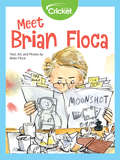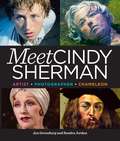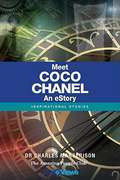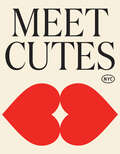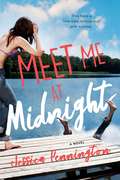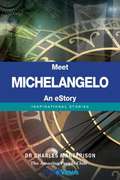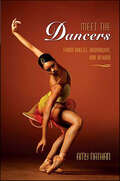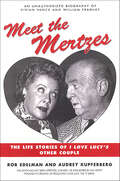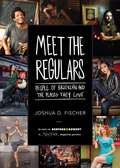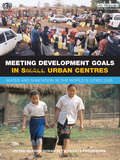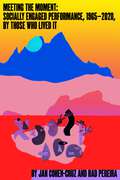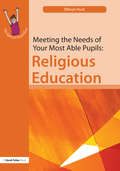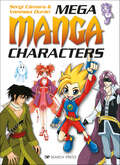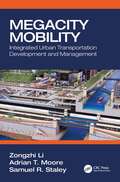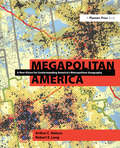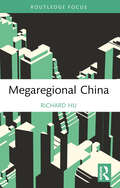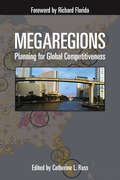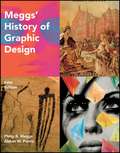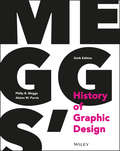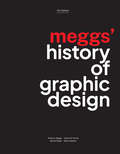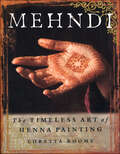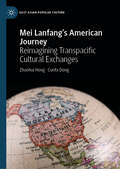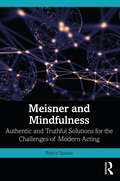- Table View
- List View
Meet Brian Floca
by Brian FlocaMeet artist and author Brian Floca and follow along as he takes you through how he creates the drawings for one of his books, Moonshot: The Flight of Apollo 11. You’ll see the drawings at every stage, from sketch to drawing to finished illustration!
Meet Cindy Sherman: Artist, Photographer, Chameleon
by Jan Greenberg Sandra JordanHow does someone become a ground-breaking artist? Does it start when you're very little and discover that you like to play dress up? Does it happen when you're ten years old and someone gives you a Polaroid camera for Christmas? Maybe it begins in college, when you're finally on your own to discover the world as you see it for the first time.Looking at the life of legendary photographer Cindy Sherman, Jan Greenberg and Sandra Jordan have created an unconventional biography, that much like Cindy Sherman's famous photographs, has something a little more meaningful under the surface. Infusing the narrative with Sherman's photographs, as well as children's first impressions of the photographs, this is a biography that goes beyond birth, middle age, and later life. It's a look at how we look at art.
Meet Coco Chanel - An eStory
by Charles MargerisonMeet Coco Chanel! She was one of the most influential style icons of all time. Everyone knows the Chanel brand, but far fewer know the amazing rags-to-riches story behind it. Take a journey from a poor house in Saumur to a convent to the glitz and glamour of Paris, where Chanel opened her first shop. Be inspired by her amazing story, as it comes alive through BioViews®.A BioView® is a short biographical story, similar to an interview. These unique stories provide an easy way of learning about amazing people who made major contributions to our world.
Meet Cutes NYC: True Stories of Love and Connection
by Jeremy Bernstein Victor Lee Aaron Feinberg"Excuse me, are you two a couple?" From the creators of @meetcutesnyc, this stunning new book—beautifully photographed and written—captures true stories of love and connection as told on the streets of NYC. Meet Cutes NYC is a breathtaking collection of 85 stories—a mix of new and fan favorites—alongside beautiful portraits of the couples, photographed exclusively for the book. Each interview opens the same way, &“Excuse me, are you two a couple?&” Followed by, &“Can you tell us the story of how you met?&” But the stories are each unique—like Chris and Clay, who met while auditioning for West Side Story (they both got it). And Joe and Liza, who met in a hardware store—while Liza was with her boyfriend at the time. There are stories of couples who met on public transportation, at a party, through friends, at work, at church—you truly never know where you might find love. There are also stories of second chances—like Mike and Karen—who met in college, broke up, and then bumped into each other again two years later; they fell into a kiss and have been married for 37 years. Beyond how they met, couples share their partner&’s favorite traits, what they love to do together, and how they make their relationships work. Meet Cutes NYC is a celebration of modern-day love connections—across all ages, genders, and backgrounds. The book is a refreshing dose of real love stories, from real people, in a gorgeous package.
Meet Me at Midnight
by Jessica PenningtonTeens waging a war of practical jokes declare peace when they fall for one another in this charming YA romantic comedy from Jessica Pennington.They have a love-hate relationship with summer.Sidney and Asher should have clicked. Two star swimmers forced to spend their summers on a lake together sounds like the perfect match. But it’s the same every year—in between cookouts and boat rides and family-imposed bonfires, Sidney and Asher spend the dog days of summer finding the ultimate ways to prank each other. And now, after their senior year, they’re determined to make it the most epic yet. But their plans are thrown in sudden jeopardy when their feud causes their families to be kicked out of their beloved lake houses. Once in their new accommodations, Sidney expects the prank war to continue as usual. But then she gets a note—Meet me at midnight. And Asher has a proposition for her: join forces for one last summer of epic pranks, against a shared enemy—the woman who kicked them out. Their truce should make things simpler, but six years of tormenting one another isn’t so easy to ignore. Kind of like the undeniable attraction growing between them.At the Publisher's request, this title is being sold without Digital Rights Management Software (DRM) applied.
Meet Michelangelo - An eStory
by Charles MargerisonMeet Michelangelo, who was born in 1485 in small village in Tuscany. In this inspirational story from The Amazing People Club, travel with him to Rome at the age of 21 and better understand how he came to complete some of the world's most influential pieces of art, including David and the awe-inspiring ceiling of the Sistine Chapel, which took him 4 years to complete. You'll hear about the challenges he faced in his long life and gain a unique perspective on the life and achievements of one of the world's most influential artists. Michelangelo's story comes to life through BioViews®. These are short biographical narratives, similar to interviews. They provide an easy way of learning about amazing people who made major contributions and changed our world.
Meet the Dancers: From Ballet, Broadway, and Beyond
by Amy NathanLots of kids enjoy dancing, but what motivates them to push past the sore muscles, early-morning technique classes, and crazy schedule required to become a professional dancer? In this book, dancers from many backgrounds talk about their different paths to success in ballet, modern, jazz, Broadway, and hiphop. They also share advice and helpful tips, such as: • practice interpreting the music and the mood of a movement, even when you're doing a standard warm-up exercise • try to be in the front row at auditions so you can see what's going on and so the judges know you're eager to be seen
Meet the Mertzes: The Life Stories of I Love Lucy's Other Couple
by Rob Edelman Audrey KupferbergMeet the Mertzes is an expansive dual biography chronicling the lives of two of America's most popular situation-comedy actors, William Frawley and Vivian Vance, who portrayed Fred and Ethel Mertz on I Love Lucy. This meticulously researched book contains interviews with Frawley's and Vance's colleagues, friends, and relatives, and explores their personal and professional lives before, during, and after I Love Lucy. With a complete filmography and videography of each, Meet the Mertzes finally sets the record straight on the lives and legacies of these compelling stars who detested one another.You'll learn about:-Vance's successful Broadway career prior to I Love Lucy-Frawley's vaudevillian roots and his passion for baseball-Vance's nervous breakdown after the collapse of her first marriage-Frawley's drinking and carousing-Lucille Ball's caustic relationship with both of her costars-Vance's hatred of being known to the world as Ethel Mertz
Meet the People with Love
by Derren Brown____________As well as being an incredible stage performer, a brilliant writer and a talented painter, Derren Brown is also a fantastic street photographer. Here, for the first time, is a selection of his work. As he writes of his passion:'Street photography is a fitting refuge for those who look at life from a distance. It both sanctifies our remoteness (by offering the standpoint of the observer) and challenges it, insisting we approach with a spritely curiosity. It offers a safe route back into the world: the camera is an entry ticket to daunting social situations and extraordinary environments where we might otherwise feel entirely out of place. Suddenly we have a role: a reason to be present. And for those of us smitten by its appeal, it provides a means of fortifying and forgetting ourselves, while extending out into the world with a controlled compassion.'
Meet the Regulars: People of Brooklyn and the Places They Love
by Joshua D. FischerBased on the column The Regulars on the New York magazine partner Bedford + Bowery, the celebrities and everyday people who love the local joints of the world’s coolest borough.Meet the Regulars captures a previously unseen and entertaining portrait of the people of Brooklyn and the places they love. In talking with the regulars at bars, restaurants, and shops in the world-famous borough, author Joshua Fischer delivers deep and delightful stories presented alongside stunning snapshots from accomplished photographers including Nina Westervelt (Vogue.com, New York Times), Phil Provencio (Variety, Saturday Night Live, and CBS), and Nicole Disser (Bedford + Bowery and Brooklyn Magazine online). Meet the Regulars reveals the great power in the connections we make with the people and places where we live.Originally an interview series on the New York magazine partner Bedford + Bowery, Meet the Regulars introduces us to a diverse and changing Brooklyn through its regulars: the first-generation American Latino café owner who drinks Coors out of a can and loves a good debate with the lawyer and plumber at his corner bar, the blogger who fixes her hair and heart at her cherished salon, the lady so loyal to her local bar she has its logo tattooed on her arm, the Asian hipster couple who drink and dance for "exercise" at their new-school Brooklyn hangout, and the burgeoning filmmaker who walks twenty blocks for sage advice from a legendary bartender inside a bowling alley.Familiar faces include party rocker Andrew W. K. spicing things up at the Thai joint from his early days, Saturday Night Live performer Sasheer Zamata reliving a break-up at her go-to brunch spot, Radiolab host Jad Abumrad sippin' whiskey to Black Sabbath, beloved NY1 news anchor Pat Kiernan chowing down on meatballs, actor Jessica Pimentel (Orange Is the New Black) championing her local metal bar, actor Kevin Corrigan (Goodfellas, Pineapple Express) contemplating a Guinness at his favorite Irish pub, and more.From Meet the Regulars:"These are stories about people finding a home in an ephemeral world of bars, restaurants, shops, and clubs that open, explode, and burn out like so many stars hidden in that bright and sleepless New York night sky." -Joshua D. Fischer, from his introductionMeet the regulars of Meet the Regulars:"It's a sense of continuity. You thread your history through a place. . . . That's what makes me a regular." -Jad Abumrad, host of public radio's Radiolab, regular at Splitty"Once you have the cell phone number of the bar owner, then you're a regular." -Twin comics the Lucas Brothers, regulars at Tutu's"I can tell if a person is cool if their vibe mixes with this place." -Sasheer Zamata, Saturday Night Live cast member, regular at Enid's"Brooklyn is this unattractive, could-never-go-to-the-prom borough. And now, not only does everyone want to take you to the prom, but everyone wants you on their arm." -Eric Adams, Brooklyn borough president, regular at Woodland"Read the book. Talk to everyone about it. . . . Move to Brooklyn with nothing but the contents of a suitcase. Be in the world's most annoying band. Get a bunch of hideous tattoos. Whatever." -Meredith Graves of punk band Perfect Pussy, regular at Roman's"This bar saved my life." -Ariel Pellman, costume designer, regular at the Way Station
Meeting Development Goals in Small Urban Centres: Water and Sanitation in the Worlds Cities 2006
by Un-HabitatHalf of the world's people live in urban areas, and roughly a third of these live in desperate poverty without access to basic amenities. Taking on the themes of UN-HABITAT's Water and Sanitation in the World's Cities (2003), this new volume focuses on the deficiencies in the provision of water and sanitation where most of the populations of the developing world live: in towns and small cities. Drawing on extensive unpublished research and 15 commissioned papers from experts involved in designing and implementing innovative projects around the world, this is the first major study of the problems facing the smaller urban centres that are recognized to be of enormous importance by governments, international agencies, NGOs and service providers. Tackling these problems is a crucial part of development and of good governance, and critical to meeting the Millennium Development Goals. The volume will be essential reading for all professionals and researchers in the relevant fields and a valuable resource for teachers and students of urban development.
Meeting the Moment: Socially Engaged Performance, 1965–2020, by Those Who Lived It
by Jan Cohen-Cruz Rad PereiraThe experiences of a diverse range of progressive theater and performance makers in their own words.Curated stories from over 75 interviews and informal exchanges offer insight into the field and point out limitations due to discrimination and unequal opportunity for performance artists in the United States over the past 55 years. In this work, performers, often unknown beyond their immediate audience, articulate diverse influences. They also reflect on how artists are educated and supported, what content is deemed valuable and how it is brought to bear, as well as which audiences are welcome and whether cross-community exchange is encouraged. The book’s voices bring the reader from 1965 through the first wave of the covid-19 pandemic in 2020. They point to more diverse and inclusive practices and give hope for the future of the art.
Meeting the Needs of Your Most Able Pupils in Religious Education: Religious Education (The Gifted and Talented Series)
by Dilwyn HuntMeeting the Needs of Your Most Able Pupils: Religious Education provides specific guidance on: recognising high ability and multiple intelligences planning, differentiation and extension/enrichment in RE teacher questioning skills support for more able pupils with special educational needs (dyslexia, ADHD, sensory impairment) homework recording and assessment beyond the classroom: Visits, summer schools, masterclasses, links with universities, businesses and other organisations. This book includes comprehensive appendices with linked resources available online that feature: useful contacts and resources lesson plans liaison sheets for Teaching Assistants homework activities monitoring sheets. This book is essential for secondary teachers, subject heads of departments, leading teachers for G&T Education (Gifted and Talented co-ordinators), SENCos and LA advisers.
Mega Manga Characters
by Sergi CàmaraDo you want to learn how to draw manga characters from scratch? Then look no further! Aimed specifically at beginners, this book includes examples from the main genres of manga characters and will teach you how to draw different characters in distinct poses. Starting with simple exercises and gradually getting more complicated, there are sections covering Kodomo (child), Shonen (teenage boy), Shojo (teenage girl) and Seinen (youth) characters to practise.To help you along the way, there are clear step-by-step instructions, with 10 exercises for each genre. Friendly chibis also pop up every so often to offer tips and advice to keep in mind while you are drawing. Extensive advice on finishing techniques ranges from colouring by computer, using pen and ink, paintbrush, felt-tip pen and pencils, both in black and white and colour.For the best start to your manga-drawing journey, this book will inspire you to explore and improve your skills.
Megacity Mobility: Integrated Urban Transportation Development and Management
by Zongzhi Li Samuel R. Staley Adrian T. MooreWorld population growth and economic prosperity have given rise to ever-increasing demands on cities, transportation planning, and goods movement. This growth, coupled with a slower pace of transportation capacity expansion and deteriorated facility restoration, has led to rapid changes in the transportation planning and policy environment. These stresses are particularly acute for megacities where degradation of mobility and facility performance have reached alarming rates. Addressing these transportation challenges requires innovative solutions. Megacity Mobility grapples with these challenges by addressing transportation policy, planning, and facilities in a multimodal context. It discusses innovative short- and long-term solutions for meeting current and future mobility needs for the world’s most dynamic cities by addressing the influence of urban land use on mobility, 3D spiderweb transportation planning, travel demand management, multimodal transportation with flexible capacity, efficient capacity utilization driven by new technologies, innovative transportation funding and financing, and performance-based budget allocation using asset management principles. It discusses emerging issues, highlights potential challenges affecting proposed solutions, and provides policymakers, planners, and transportation professionals a road map to achieving sustainable mobility in the 21st century. Zongzhi Li is a professor and the director of the Sustainable Transportation and Infrastructure Research (STAIR) Center at Illinois Institute of Technology (IIT). Adrian T. Moore is vice president of policy at Reason Foundation in Washington, D.C., with focuses on privatization, transportation and urban growth, and more. Samuel R. Staley is the director of the DeVoe L. Moore Center in the College of Social Sciences and Public Policy at Florida State University.
Megapolitan America
by Robert Lang Arthur NelsonWith an expected population of 400 million by 2040, America is morphing into an economic system composed of twenty-three 'megapolitan' areas that will dominate the nation’s economy by midcentury. These 'megapolitan' areas are networks of metropolitan areas sharing common economic, landscape, social, and cultural characteristics. The rise of 'megapolitan' areas will change how America plans. For instance, in an area comparable in size to France and the low countries of the Netherlands and Belgium – considered among the world's most densely settled – America's 'megapolitan' areas are already home to more than two and a half times as many people. Indeed, with only eighteen percent of the contiguous forty-eight states’ land base, America's megapolitan areas are more densely settled than Europe as a whole or the United Kingdom. Megapolitan America goes into spectacular demographic, economic, and social detail in mapping the dramatic – and surprisingly optimistic – shifts ahead. It will be required reading for those interested in America’s future.
Megaregional China (Routledge Research in Sustainable Planning and Development in Asia)
by Richard HuThis book unravels China’s new megaregional structure, new megaregional planning and development, new megaregional governance, and new regional planning system. It draws upon a diversity of megaregional cases: city clusters of the Beijing–Tianjin–Hebei region, Yangtze River delta region, and Greater Bay Area; and metropolitan circles of Chengdu, Hangzhou, Hong Kong, Shanghai, Shenzhen, and Zhengzhou.Megaregions are the new form of Chinese-style urbanisation. China’s new discourse of ‘high-quality development’ and ‘new-type urbanisation’ is reshaping its megaregional strategy. Imbalance and fragmentation characterise the diversity of megaregions - developed or developing, coastal or inland. The central goal of megaregional planning and governance is to achieve integrated, balanced development of them. Hu challenges the official notion of ‘top-level design’ that dominates the planning, governance, and development of China’s megaregions. Instead, he argues for the importance of engaging nongovernmental stakeholders, rebalancing the government-market relationality, encouraging bottom-up initiatives, and enabling grassroots ingenuity.The volume offers the first and most comprehensive study of megaregional China in the new contexts of both national development and urban development. It will be of interest to anyone looking into urban and regional development, and Chinese studies.
Megaregions: Planning for Global Competitiveness (Regions And Cities Ser.)
by Catherine Ross Cheryl K. Contant Jason Barringer Scott Cmapbell Adjo A. Amekudzi Tridib BanerjeeThe concept of "the city" --as well as "the state" and "the nation state" --is passé, agree contributors to this insightful book. The new scale for considering economic strength and growth opportunities is "the megaregion," a network of metropolitan centers and their surrounding areas that are spatially and functionally linked through environmental, economic, and infrastructure interactions. Recently a great deal of attention has been focused on the emergence of the European Union and on European spatial planning, which has boosted the region's competitiveness. Megaregions applies these emerging concepts in an American context. It addresses critical questions for our future: What are the spatial implications of local, regional, national, and global trends within the context of sustainability, economic competitiveness, and social equity? How can we address housing, transportation, and infrastructure needs in growing megaregions? How can we develop and implement the policy changes necessary to make viable, livable megaregions? By the year 2050, megaregions will contain two-thirds of the U.S. population. Given the projected growth of the U.S. population and the accompanying geographic changes, this forward-looking book argues that U.S. planners and policymakers must examine and implement the megaregion as a new and appropriate framework. Contributors, all of whom are leaders in their academic and professional specialties, address the most critical issues confronting the U.S. over the next fifty years. At the same time, they examine ways in which the idea of megaregions might help address our concerns about equity, the economy, and the environment. Together, these essays define the theoretical, analytical, and operational underpinnings of a new structure that could respond to the anticipated upheavals in U.S. population and living patterns.
Meggs' History of Graphic Design
by Philip B. Meggs Alston W. PurvisWinner of the First-Ever QED (Quality, Excellence, Design) award by Digital Book World This is the unrivaled, comprehensive, and award-winning reference tool on graphic design recognized for publishing excellence by the Association of American Publishers. Now, this Fifth Edition of Meggs' History of Graphic Design offers even more detail and breadth of content than its heralded predecessors, revealing a saga of creative innovators, breakthrough technologies, and important developments responsible for paving the historic paths that define the graphic design experience. In addition to classic topics such as the invention of writing and alphabets, the origins of printing and typography, and postmodern design, this new Fifth Edition presents new information on current trends and technologies sweeping the graphic design landscape-such as the web, multimedia, interactive design, and private presses, thus adding new layers of depth to an already rich resource. With more than 1,400 high-quality images throughout-many new or newly updated-Meggs' History of Graphic Design, Fifth Edition provides a wealth of visual markers for inspiration and emulation. For professionals, students, and everyone who works with or loves the world of graphic design, this landmark text will quickly become an invaluable guide that they will turn to again and again.
Meggs' History of Graphic Design
by Philip B. Meggs Alston W. PurvisNote from the publisher: An access card with redemption code for the online Interactive Resource Center is included with all new, print copies or can be purchased separately. If you rent or purchase a used book with an access code, the access code may have been redeemed previously and you may have to purchase a new access code. The online Interactive Resource Center, contains resources tied to the book, such as:Interactive Resources: * Flashcards featuring images from book for image identification self-study * Self-test assessment by chapter * Image Gallery featuring key designers and their workDownloadable Resources: * Indices of key terms and people***Winner of the First-Ever QED (Quality, Excellence, Design) award by Digital Book World*** This is the unrivaled, comprehensive, and award-winning reference tool on graphic design recognized for publishing excellence by the Association of American Publishers. Now, this Fifth Edition of Meggs' History of Graphic Design offers even more detail and breadth of content than its heralded predecessors, revealing a saga of creative innovators, breakthrough technologies, and important developments responsible for paving the historic paths that define the graphic design experience. In addition to classic topics such as the invention of writing and alphabets, the origins of printing and typography, and postmodern design, this new Fifth Edition presents new information on current trends and technologies sweeping the graphic design landscape--such as the web, multimedia, interactive design, and private presses, thus adding new layers of depth to an already rich resource.With more than 1,400 high-quality images throughout--many new or newly updated--Meggs' History of Graphic Design, Fifth Edition provides a wealth of visual markers for inspiration and emulation. For professionals, students, and everyone who works with or loves the world of graphic design, this landmark text will quickly become an invaluable guide that they will turn to again and again.
Meggs' History of Graphic Design
by Philip B. Meggs Alston W. Purvis Mark Sanders Sandra MaxaThe bestselling graphic design reference, restructured by themes to represent motivations for visual communication over time Graphic designers must have a thorough understanding of the field’s rich history in order to inspire and inform their work. Meggs’ History of Graphic Design is the industry’s original reference, serving as an essential resource for a generation of professionals, scholars, and students. With over 1,400 high-quality images throughout, this visually stunning text guides you through artistic innovators, breakthrough tools and technologies, and significant artifacts that have pushed the boundaries of graphic design throughout its history. The initial publication of this book was heralded as a landmark, and author Philip B. Meggs is credited with significantly shaping the academic field of graphic design. This new edition foregrounds cultural and social context and elevates diverse voices that are pivotal contributors to the history of graphic design. This seventh edition also covers: Artifacts, methods, designers, and events from pre-history to the twenty-first century Technological advancements in media and design, from the earliest technologies to recent developments A timeline for studying graphic history from multiple viewpoints and culturally diverse approaches Updated ancillary materials, including an instructor’s manual, key terms, and quizzes You can’t master a field without knowing its history. Meggs’ History of Graphic Design presents a diverse, visually spectacular history of graphic design for students and professionals. The updates to this edition solidify its continuing legacy as a must-have in any contemporary graphic design library.
Mehndi: The Timeless Art of Henna Painting
by Loretta RoomeMehndi, the ancient art of painting on the skin with henna, beautifies the body, rejuvenates the spirit, and celebrates the joys of creativity and self-expression. More than just a temporary tattoo, mehndi offers us a way to participate in a centuries-old tradition still practiced in India, Africa, and the Middle East.In this stunning and authoritative book, Loretta Roome traces the origins and meanings of traditional designs, demonstrates how to create them on the skin, and reveals the recipes, tools, and techniques needed to paint designs that range from simple to complex. The result of years of research and the author's experience as one of the nation's foremost mehndi artists, Roome's book offers practical information, creative inspiration, and many suggestions for enhancing the playful, intimate, sensual, erotic, and spiritual aspects of the ancient and amazing art of mehndi.
Mei Lanfang and the Twentieth-Century International Stage
by Min TianThe first book-length study in any language of the presence and influence of Mei Lanfang, the internationally known Chinese actor who specialized in female roles on the twentieth-century international stage. Tian investigates Mei Lanfang's presence and influence and the transnational and intercultural appropriations of his art.
Mei Lanfang's American Journey: Reimagining Transpacific Cultural Exchanges (East Asian Popular Culture)
by Zhaohui Hong Cunfa DongThis groundbreaking study examines Peking Opera legend Mei Lanfang&’s 1930 U.S. visit through extensive primary sources and a cross-cultural lens. It meticulously chronicles his 76 performances over 182 days, reconstructing his daily itinerary, highlighting key events, and estimating box office revenues. Drawing on over 1,000 local newspaper reports from 34 states and territories, as well as diaries, memoirs, archival records, and advertisements, this book offers fresh insights into U.S.-China cultural exchange nearly a century ago—a topic with enduring contemporary relevance. Employing a mixed-methods approach, it integrates grounded theory, abductive reasoning, and the theory of para-text to deliver a rigorous and innovative analysis. As both a theoretical contribution and an analytical framework, the book reimagines transpacific cultural exchange, systematically exploring Peking Opera diplomacy, which involves non-governmental individuals and collectives engaged in cultural, artistic, commercial, and educational interactions. Furthermore, it delves into inculturation, examining how Mei Lanfang&’s visit contributed to the localization of Chinese culture in America, fostering cultural accommodation, adaptation, and integration. Finally, it introduces the theory of marginalization studies, shedding light on the peripheral figures and events that played a crucial role in Mei&’s visit. By combining rigorous analysis with innovative theoretical perspectives, this book reinterprets and reimages the significance of Mei Lanfang&’s visit, offering an essential resource for scholars and anyone interested in modern Chinese history, transpacific studies, cultural diplomacy, and U.S.-China relations.
Meisner and Mindfulness: Authentic and Truthful Solutions for the Challenges of Modern Acting
by Royce SparksMeisner and Mindfulness: Authentic and Truthful Solutions for the Challenges of Modern Acting is the first book that reveals how Meisner and mindfulness can be united to create strong results for actors and help them navigate the challenges of the digital age. The twenty-first century has created an entirely new set of demands and pressures on the working actor, including an acceleration of the digital age and the complications of COVID-19, which have led to auditions, rehearsals, and even whole performances happening entirely in isolation. This book combines a modern rethinking of the Meisner technique with a complementary set of tools from mindfulness meditation to offer profound solutions to these growing challenges, addressing the demands of a post-coronavirus industry as well as the pressures of acting in the digital era. In this ground-breaking expansion of the technique, readers will discover how it is possible to train some of the deepest values of living truthfully under a given set of circumstances, both with other actors and whilst alone. Since the 1950s the Meisner technique has aided the actor in navigating the demands unique to their time. This book is a powerful reminder that, even in the midst of so many changes and challenges, the truthfulness that has defined outstanding performances across generations is still within reach. Full of easily accessible mindfulness and Meisner exercises and principles for practice-based support, Meisner and Mindfulness will be illuminating to working actors, directors, students and instructors of acting, and practitioners of the Meisner technique looking to develop the authenticity, immediateness, and closeness essential to great acting. The book also includes access to an online supplement featuring additional exercises and concepts, including new ways to incorporate Meisner exercises into training sessions, suggestions for how Meisner-oriented companies can use exercises such as repetition in rehearsals, and discussions for how to set up a facilitated Meisner group.
